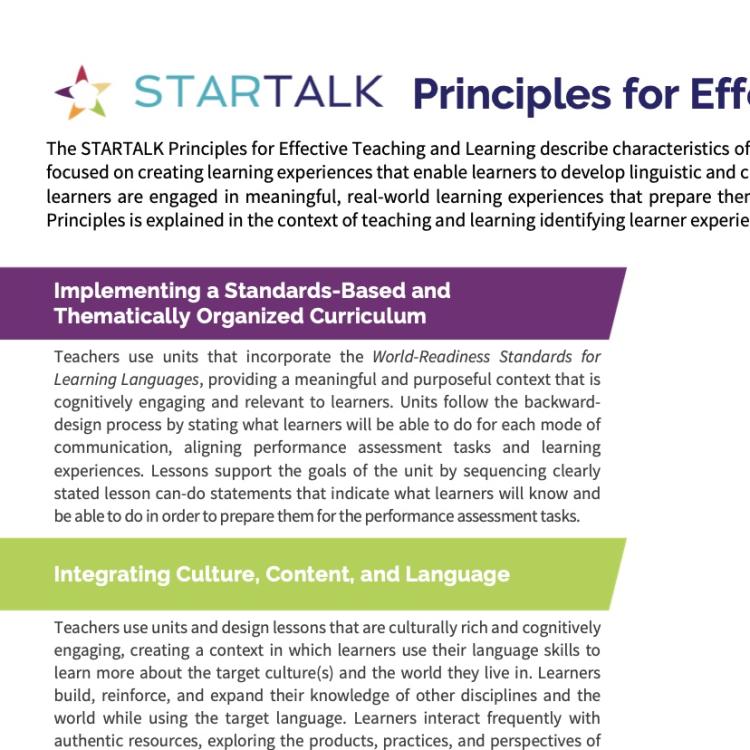STARTALK Principles for Effective Teaching & Learning
The STARTALK Principles for Effective Teaching and Learning describe characteristics of highly effective language teaching and learning. Each STARTALK Principle is focused on creating learning experiences that enable learners to develop linguistic and cultural competence. Educators apply the STARTALK Principles to ensure that learners are engaged in meaningful, real-world learning experiences that prepare them to use the target language beyond the classroom. Each of the STARTALK Principles is explained in the context of teaching and learning identifying learner experiences that are possible because of the work done by the teacher.
Teachers use units that incorporate the World-Readiness Standards for Learning Languages, providing a meaningful and purposeful context that is cognitively engaging and relevant to learners. Units follow the backward- design process by stating what learners will be able to do for each mode of communication, aligning performance assessment tasks and learning experiences. Lessons support the goals of the unit by sequencing clearly stated lesson can-do statements that indicate what learners will know and be able to do in order to prepare them for the performance assessment tasks.
Teachers use units and design lessons that are culturally rich and cognitively engaging, creating a context in which learners use their language skills to learn more about the target culture(s) and the world they live in. Learners build, reinforce, and expand their knowledge of other disciplines and the world while using the target language. Learners interact frequently with authentic resources, exploring the products, practices, and perspectives of the target culture(s). They have opportunities to communicate and interact appropriately with others who speak the target language.
Learners benefit from an environment in which teachers and learners collaborate as partners in the learning process. Teachers make instructional decisions based on learners’ ages, interests, abilities, and needs. Teachers create multiple opportunities for learners to engage in real-world tasks in the target language that spark curiosity and invite inquiry. Teachers plan multiple opportunities for learner-to-learner interaction, enabling learners to collaborate and communicate about topics that are meaningful to them.
Teachers share unit and lesson goals with learners and monitor how well learners are doing in meeting those goals. Learners engage in relevant real- world performance tasks to demonstrate how well they are meeting the performance targets and goals of the unit for each mode of communication. Teachers use evidence from performance assessment tasks and formative checks for learning during lessons to provide timely descriptive feedback to learners and adjust instruction as needed.
Teachers plan how to facilitate learning through the use of the target language and ensure that the target language is used at least 90 percent of the time. Teachers deliberately determine if and when it is necessary to translate. Teachers use a variety of strategies to make the target language comprehensible and frequently check for understanding in a variety of ways in order to modify input as necessary. Learners have frequent meaningful opportunities for target language production and are able to engage in learning activities without resorting to their native language.
Teachers select authentic texts and resources appropriate for the theme and performance targets of the unit. Teachers plan how to make the texts and resources comprehensible and accessible to learners. Learners engage frequently with age-appropriate resources that are intentionally selected to appeal to the interests of the learners.
Resource Topic
Resource Project
Resource Type
Publication Year
2019

